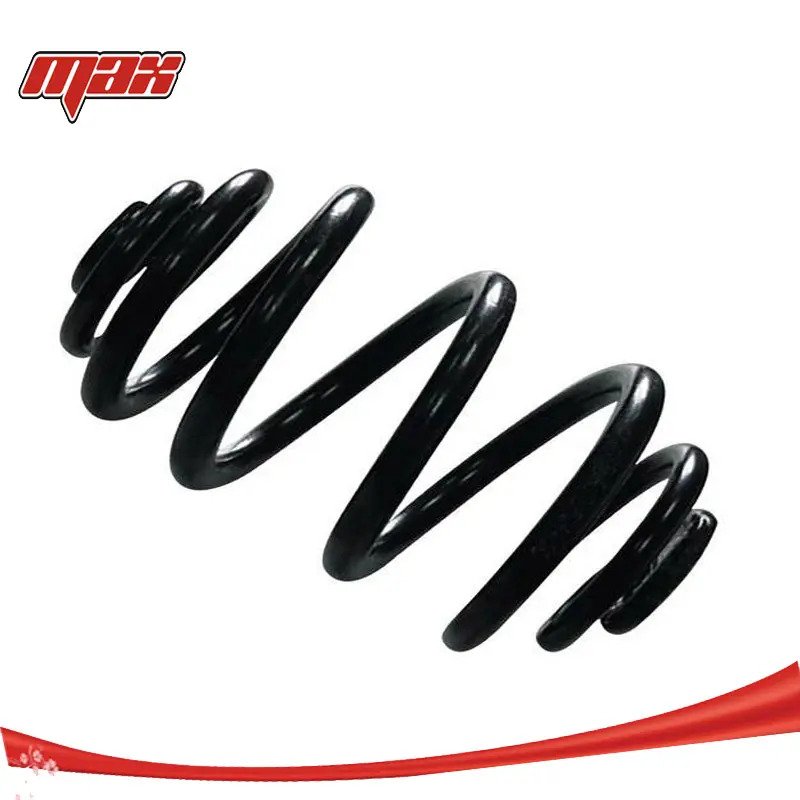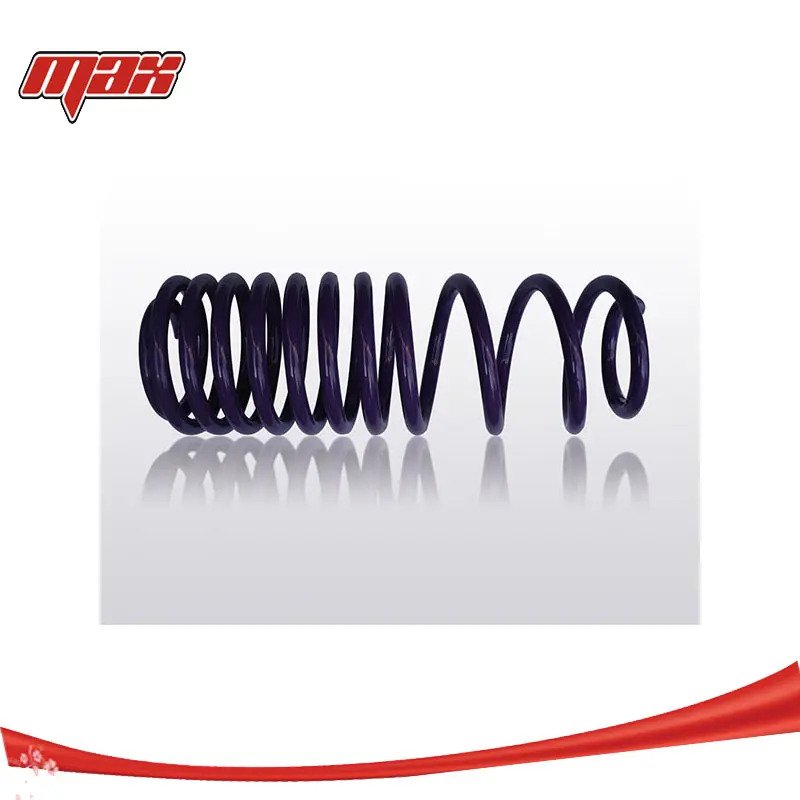
A coil spring helps a car handle bumps and rough roads. This part sits in the suspension and supports the weight of the vehicle. Drivers and passengers feel less shaking and fewer jolts because the car coil spring absorbs impacts. Coil springs work with the shock absorber spring to keep the ride comfort high and the car stable. By keeping tires pressed to the road, coil springs improve control and safety. Understanding how a shock absorber spring works lets people notice problems early and keep their vehicles running smoothly.
Key Takeaways
Coil springs hold up the car’s weight. They also take in bumps from the road. This makes the ride smoother for people in the car.
You should check coil springs often. This helps stop damage and keeps you safe. Watch for things like tires wearing unevenly or loud sounds.
Good coil springs help you control the car better. They also help the tires grip the road. This is important on bumpy or wet roads.
Picking strong coil springs, like ones from Max Auto Parts, makes them last longer. It also helps the car work better. You will not need repairs as often.
If you ignore coil spring problems, the ride gets rough. You may lose control of the car. Other parts can break, and repairs will cost more.
Coil Spring Function in Car Suspension

Supporting Vehicle Weight with Coil Springs
Coil spring suspension helps hold up the car. These springs sit between the wheels and the car’s body. They support the whole weight of the car, including people and cargo. When the car carries more weight, coil springs squeeze to balance the load. This keeps the car level and steady, even on bumpy roads.
Tip: Good coil spring suspension can make rides smoother and keep the car steady, especially when carrying heavy things.
Coil springs help the suspension keep the car balanced. This balance helps the car work better and makes driving safer.
Absorbing Road Impacts and Shocks
Coil springs help absorb shocks from the road. When the car goes over bumps or holes, coil springs squeeze and stretch. This action takes in shocks and keeps the ride smooth. Without coil springs, every bump would shake the car and make the ride rough.
Coil springs take in shocks and shakes from the road.
They squeeze when hitting bumps, which helps absorb the hit.
This squeezing stops the hit from reaching the car’s body and people, making the ride smoother.
Springs let the wheels move up to take in bumps.
They cut down shaking, making the ride more comfy for everyone.
Dampers work with springs to stop too much bouncing.
Coil spring suspension works with shock absorbers to make rides better. Together, they help drivers and passengers stay comfortable, even on rough roads.
Maintaining Tire Contact and Stability
Keeping tires on the road is important for safety. Coil springs help press the tires against the road. This grip helps the car turn and stop better. When coil springs work right, they keep the car at the right height and the wheels lined up.
Coil springs take in shocks and keep the car at the right height, which is important for stability and comfort.
Good coil springs keep wheels lined up, stopping uneven tire wear and helping grip when speeding up or stopping.
Not taking care of coil springs can cause uneven tire wear, which hurts handling and gas use.
Old or weak coil springs can hurt handling and stability, make the car lean more, and lower tire grip.
This drop in performance can cause too much bouncing, make rides less comfy, and wear out other suspension parts faster.
Coil spring suspension also helps the car turn and stop. The springs spread out forces, which helps take in shocks from rough roads and keeps the car steady. Cars made for performance often use stiffer coil springs to cut down leaning and help handling.
Note: Good coil spring suspension helps take in shocks, keep tires on the road, and give stability, making every drive safer and more comfortable.
Coil Spring Benefits for Comfort and Safety
Smoother Rides for Drivers and Passengers
Coil springs help make car rides smoother. They take in force from bumps and rough roads. This means less shaking inside the car. Drivers and passengers feel more comfortable. New spring designs, like C-shaped ones, can make cars handle bumps even better. These changes help people feel more relaxed when driving. Experts say knowing how coil springs work helps us see why rides are smoother. Good coil springs mean fewer jolts for everyone. Trips feel nicer and more calm.
Enhanced Vehicle Control and Traction
Coil springs help keep tires on the road. This makes cars safer when turning or stopping. They work with shock absorbers to control bumps. When a car hits a bump, the spring squeezes. The shock absorber slows down the movement. This keeps tires touching the road. It helps the car grip better and handle well. Experts think coil springs are better than leaf springs. Coil springs move with the suspension’s shape. This gives cars better handling. The main benefits are:
Make rides smoother
Help cars handle better
Lower damage to suspension parts
Coil springs are important for safety. They help cars drive better on wet or bumpy roads.
Reducing Wear on Suspension Parts
Good coil springs help the suspension work right. They keep tires touching the road and spread weight evenly. This lowers stress on other parts. It means fewer repairs and longer-lasting parts. Cars with good coil springs have parts that last longer. Bad coil springs can break faster from rust or wear. This causes more repairs. Picking the right coil spring keeps rides smooth. It also helps the suspension stay healthy.
Broken Coil Spring Problems and Warning Signs

Common Causes of Coil Spring Failure
Many drivers have coil spring problems for different reasons. Corrosion is a main cause of broken springs. If the coating cracks, water and road salt touch the metal. This makes rust form and weakens the spring. Blown tyres or wheels out of balance stress the suspension more. This can make coil springs break. If shock absorbers leak fluid, coil springs work harder. This raises the chance of breaking. Road salt and water make oxidation happen faster. This makes coil springs weak and easy to snap. Salt damages metal and shortens the life of suspension parts.
Corrosion from cracked coatings
Blown tyres and wheel imbalances
Fluid leaks in struts or shock absorbers
Signs of a Broken Coil Spring
Drivers can find broken coil springs by checking for warning signs. Tyres may wear out too fast. The car might hit the ground over bumps. It could lean when turning. Cracks, rust, or damage on the spring show problems. The car may sit uneven or make loud noises. Clunking or squeaking sounds from the suspension are bad signs. Handling gets worse and bouncing feels rough. During checks, look for sagging, strange tyre wear, loud noises, and swaying when turning.
If your car gets louder underneath, coil springs or shocks may need to be changed. Check right away if you hear too much noise.
Risks of Driving with Damaged Springs
Driving with a broken coil spring is risky. The ride gets rough and bouncy over bumps. The car is harder to control, especially when turning. Other suspension parts can get damaged and cost more to fix. A broken coil spring can make the car sway or lean. Steering gets tough and stopping takes longer. These problems make accidents more likely, especially at high speeds or on rough roads.
Risk Type | Description |
|---|---|
Rough Ride | A broken coil spring causes bouncing and makes driving uncomfortable. |
Less Control | More sway from a broken spring can make you lose control, especially when turning. |
Damage to Other Parts | A broken coil spring can hurt other car parts and cost more to fix. |
A broken coil spring can make the car lean or sway. This makes steering and control hard. It is very dangerous at high speeds or on rough roads. A broken coil spring can also make braking worse. Stopping takes longer and accidents can happen more easily.
Coil Spring Replacement and Maintenance Tips
When to Replace Coil Springs
Drivers need to check coil springs often to keep cars safe. Mechanics say to look at coil springs during regular checks or oil changes. In places with cold or wet weather, check coil springs more often. This helps find rust or damage early. Regular checks can show sagging, cracks, or other problems before the spring breaks. Sometimes, you must replace coil springs even if you do not see damage. Signs are a weaker ride, tiny cracks, or strange car movement. Other signs are thin coils, rough spots, or loose springs. If the car bounces a lot or feels shaky, the coil spring may be worn out. Changing coil springs early stops bigger problems and keeps the suspension working well.
Tip: Look at coil springs often to find damage early, especially where it rains a lot or roads have salt.
Choosing Quality Coil Springs from Max
Picking a good coil spring is important for safety and how the car drives. Max Auto Parts sells the Shock Absorber Spring made from strong steel like 55CrSI and 60Si2Mn. These steels are tough and do not rust easily, so the springs last longer and take in shocks better. Max Auto Parts has TS16949 certification, which means they follow strict rules and make good products. Getting a professional to put in new coil springs helps them work better and last longer. Trained workers use special tools and follow the right steps. This lowers mistakes and keeps the suspension safe. It also makes sure the new springs fit and work right.
There are different coil spring types and other springs for cars. The table below shows the main types and what they do:
Type of Spring | Application | Performance Characteristics |
|---|---|---|
Coil Springs | High-performance cars, sedans | Stability, absorb shocks, smooth ride |
Leaf Springs | Trucks, SUVs | High load capacity, lateral stability |
Gas Springs | Hoods, trunks, tailgates | Controlled movement, adjustable force |
The best spring type depends on the car and how you use it. Max Auto Parts has many coil spring types for different needs. Always pick certified, high-quality springs and get them put in by professionals for the best results.
Coil springs are important for making cars safe and comfy. Checking them often and changing them on time stops surprise problems and saves money.
New models can guess when springs will wear out and help cut suspension costs by almost half.
Old springs can make it take longer to stop and make crashes more likely.
Good coil springs like Max Shock Absorber Spring take in bumps and stop shaking. Drivers get smoother rides and better control, even on bumpy roads. Picking trusted parts helps keep every trip safer.
FAQ
What is the main job of a coil spring in a car?
A coil spring supports the car’s weight and absorbs bumps from the road. It helps keep the ride smooth and the car stable. Drivers and passengers feel less shaking because of the coil spring.
How often should someone check their car’s coil springs?
Most experts suggest checking coil springs during regular maintenance or oil changes. In areas with harsh weather, more frequent checks help spot rust or damage early.
Can a car drive with a broken coil spring?
A car can move with a broken coil spring, but it becomes unsafe. The ride feels rough, and the car may lean or bounce. Other parts can wear out faster, increasing repair costs.
What are signs that a coil spring needs replacement?
Common signs include uneven tire wear, loud noises from the suspension, or the car sitting lower on one side. Drivers may also notice more bouncing or poor handling.
Are all coil springs the same for every car?
No, coil springs come in different sizes and strengths. Each car model needs a specific type. Using the right coil spring ensures the best performance and safety.
